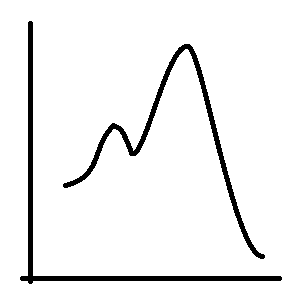It is perhaps worth noting that the 'rate determining step' is an approximation.
It is technically possible to model any reacting system without it, by using numerical methods.
It is even possible to model certain systems fully analytically.
Take for instance a sequence of 2 consecutive irreversible reactions:
$\ce{A ->[k_A] B ->[k_B] C}$
which is described by:
$\frac{dA}{dt}=-k_A A$
$\frac{dB}{dt}=+k_A A-k_B B$
$\frac{dC}{dt}=+k_B B$
This system of differential equations has an analytical solution. Assuming that only $\ce A$ is present at $t=0$, at a concentration $\ce{A(0)}$:
$A(t) = A(0) e^{-k_A t}$
$B(t) = \frac {k_A A(0)}{k_B-k_A} [e^{-k_A t}-e^{-k_B t}]$
$C(t) = \frac {A(0)}{k_B-k_A} [k_B (1-e^{-k_A t}) -k_A (1-e^{-k_B t})]$
Suppose that the first reaction is 100 times faster than the second ($k_A = 1, k_B = 0.01$).
If you plot the 3 concentrations for $t \in [0,100]$, you will see $A$ disappear quite fast and $B$ reach its maximum when $C$ is still quite low.
In other words, you can assume that the second step is the 'rate determining' one, i.e. assume that all $A$ almost immediately turns into $B$, so $B(0) \approx A(0)$, and model only the second and third reaction:
$B(t) \approx A(0) e^{-k_B t}$
$C(t) \approx A(0) [1-e^{-k_B t}]$
The same result can be reached directly from the exact analytical solution, by setting $k_A >> k_B$:
$B(t) \approx \frac {k_A A(0)}{-k_A} [-e^{-k_B t}] = A(0) e^{-k_B t}$
$C(t) = \frac {A(0)}{k_B-k_A} [k_B (1-e^{-k_A t}) -k_A (1-e^{-k_B t})] \approx \frac {A(0)}{-k_A} [-k_A (1-e^{-k_B t})] = A(0) [1-e^{-k_B t}]$
Suppose instead that the first reaction is 100 times slower than the second ($k_A = 0.01, k_B = 1$), and plot the 3 concentrations for $t \in [0,1000]$.
You will see $A$ disappear according to a rather typical first order decay, $C$ form equally typically, whereas $B$ remains barely visible at the bottom of the plot (in some contexts $B$ would be called a 'stationary intermediate').
You can assume that the first step is the 'rate determining' one, i.e. assume that $\frac {dB}{dt} \approx 0$, and consequently $\frac {dC}{dt} = k_B B \approx k_A A$, and model only the first and third reaction:
$A(t) = A(0) e^{-k_A t}$
$C(t) \approx A(0) [1-e^{-k_A t}]$
Here, too, the same result can be reached directly from the exact analytical solution, by setting this time $k_A << k_B$:
$A(t) = A(0) e^{-k_A t}$
$C(t) = \frac {A(0)}{k_B-k_A} [k_B (1-e^{-k_A t}) -k_A (1-e^{-k_B t})] \approx \frac {A(0)}{k_B} [k_B (1-e^{-k_A t})] = A(0) [1-e^{-k_A t}]$
In both these 'extreme' cases, the approximate curves described by the 'rate determining step' approximation fit quite closely the exact curves, but there is nothing better than the latter, for a more accurate account of the system.
Also considering that one does not know a priori if a given approximation holds true or not for a particular system.
It is sufficient to set $k_A = 1, k_B = 1.01$, i.e. have two consecutive reactions of comparable rate, and plot the exact concentrations for $t \in [0,10]$, to see that $C(t)$ is not really well described by either approximate rds solution.
Luckily these days there are plenty of excellent software solutions allowing to model systems of any complexity via very accurate numerical methods.


